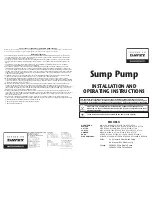
Rotary Tool
3
Visit www.princessauto.com for more information
8352965
V 3.02
WORK AREA
1. Operate in a safe work environment. Keep your work area clean and well lit. If operating in a
damp location is unavoidable, use a residual current device (RCD) protected supply. Use of a
ground fault circuit interrupter (GFCI) reduces the risk of electrical shock.
2. Do not operate power tools in explosive atmospheres, such as in the presence of flammable
liquids, gases or dust. Power tools create sparks that may ignite the dust or fumes.
3. Keep anyone not wearing the appropriate safety equipment away from the work area.
NOTE: Minimize distractions in the work environment. Distractions can cause you to lose
control of the tool.
4. Always lock up tools and keep them out of the reach of children.
PERSONAL SAFETY
CAUTION! Wear protective equipment approved by the Canadian Standards Association (CSA) or
American National Standards Institute (ANSI) when using the rotary tool.
1. Dress properly, wear protective equipment. Use breathing, ear, eye, face, foot, hand, and head
protection. Always wear ANSI approved impact safety goggles, which must provide both frontal
and side protection. Protect your hands with suitable gloves. Wear a full face shield if your
work creates metal filings or wood chips. Protect your head from falling objects by wearing a
hard hat. Wear an ANSI approved dust mask or respirator when working around metal, wood
and chemical dusts and mists. Wear ANSI approved earplugs. Protective, electrically non-
conductive clothes and non-skid footwear are recommended when working. Wear steel-toed
boots to prevent injury from falling objects.
2. Control the tool, personal movement and the work environment to avoid personal injury or
damage to the tool. Stay alert, watch what you are doing and use your common sense.
3. Keep articles of clothing, jewellery, hair, etc., away from moving parts to avoid entanglement
with tool.
4. Do not operate any machine / tool when tired or under the influence of drugs, alcohol
or medications.
5. Do not overreach when operating a tool. Proper footing and balance enables better control of a
tool in unexpected situations.
6. Use clamps or other practical ways to support or secure the work piece to a stable platform.
Holding the work piece by hand or against your body is not stable and may lead to loss of
control and injury.




































